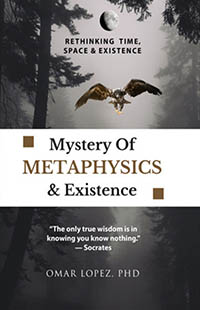
EXTRACT FOR
Mystery of Metaphysics & Existence
(Omar Lopez)
Table of ContentsForeword Chapter 1: Anthropic Principle Chapter 2: Branches of Metaphysics Chapter 3: Meditation Chapter 4: Precognition Chapter 5: Your Space and Time Chapter 6: Your Inner Self Chapter 7: Extrasensory Perception Chapter 8: Existence Chapter 9: Consciousness Conclusion Metaphysical Dictionary ForewordLife is meaningful in what sense? What do
we mean by consciousness? Why is there something, rather than nothing? Are
there any nonphysical entities? There are probably a lot of other questions in
your head right now. The problem is we are still missing pieces of the puzzle.
It takes a thorough understanding of metaphysics to answer questions like these.
Reading this book will allow you to gain a better understanding of what
metaphysics is while logically trying to understand the world around you.
“In appearance, I’m a thing moving about in space. In reality, I am that moving space itself.” Douglas Harding Chapter 1: Anthropic PrincipleMetaphysics involves studying the nature of
reality, either known or unknown, by exploring the nature of reality,
metaphysics describes what is exactly real. In addition, it shows the
relationship between matter and mind, consciousness
and reality, and between potentiality and actuality. Metaphysics deals with
some very abstract questions that many philosophers, physicists, and scientists
believe have no logical or mathematical explanations.
“METAPHYSICS, LIKE
THE BRANCHES OF A TREE, OPENS
TO ALL THERE IS IN THE UNIVERSE AND BEYOND.” Humans have contemplated the meaning of our life for decades. From philosophers debating whether their minds could be trusted to provide accurate interpretations of our reality to physicists attempting to interpret the weirder aspects of quantum physics and relativity, we've learned that some aspects of our universe appear to be objectively true for all observers, while others are subject to the influence and properties of the observer. The Universe has a set of rules, and physicists have been able to decipher at least some of them. On a continuous, non-quantum level, we comprehend how gravity operates.  We are familiar (mathematically), with a substantial number of the particles that exist (based on the Standard Model) and their interactions with the other fundamental forces. We know that we exist, made up of the same particles and subject to the same natural rules as everything else in the Universe. The Universe is consistent with our existence at this precise position in space-time because we exist as observers, here and now, within it. And that our universe, including the fundamental parameters on which it depends, must exist in such a way that observers like ourselves at some point exist within it. Today, these two statements are referred to, respectively, as the Weak Anthropic Principle and the Strong Anthropic Principle. They can enable us to make tremendously significant inferences and limits about the nature of our universe when applied appropriately. |



